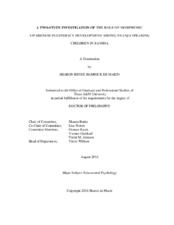A Two-Study Investigation of the Role of Morphemic Awareness in Literacy Development Among Nyanja Speaking Children In Zambia
Date
2016-08-08Metadata
Show full item recordAbstract
Students in Sub-Sahara Africa face a deluge of academic challenges that hinder literacy development. Post-colonization remnants in Zambia are evident in its educational system that, until recent changes in educational language policy, used English in academic contexts, although students primarily use native languages (e.g., Nyanja) in all other settings. Zambia has one of the lowest student achievement rates in Sub Sahara Africa, as well as the world. Research demonstrates that morphemic awareness underpins and facilitates reading, vocabulary, spelling, writing, and overall literacy development. Such research sought to understand the extent to which 206 Zambian 6th grade multi lingual students tapped into their English morphemic knowledge to help them with reading comprehension and writing tasks.
Students were evaluated with a range of standardized measures and a researcher-created writing task. Hierarchical multiple regression analyses revealed that morphemic awareness had a 2.2% predictive ability above other predictors in reading comprehension (ΔR^2 = 2.2%, ΔF (3, 1) = 31.147, p < .001; study 1) and 2.3% in writing ability (ΔR^2 = 2.3%, ΔF (3, 1) = 19.977, p < .001; study 2). Morphemic awareness, (β = .438, t = 5.581, p <.001; study 1) and (β =.413, t =4.470, p <.001); study 2), was shown to have the strongest relationship to both reading comprehension and writing ability, respectively. These results confirm the critical role of morphemic awareness in literacy development, and it can be argued that morphemic awareness needs to be taught explicitly and systematically.
Citation
Hamrick De Marin, Sharon Renee (2016). A Two-Study Investigation of the Role of Morphemic Awareness in Literacy Development Among Nyanja Speaking Children In Zambia. Doctoral dissertation, Texas A & M University. Available electronically from https : / /hdl .handle .net /1969 .1 /157757.


